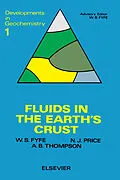Fluids in the Earth's Crust explores the generation and migration of fluids in the crust and their influence on the structure. This book also deals with the collection and concentration of these fluids into commercially possible reservoirs or their fossil trace formed as ore bodies.
Chapter one of this book discusses fluid motion and geochemical and tectonic processes. It then defines fluid, discusses the rocks in the surface environment, and provides evidence of the changes of a rock's position and the motion of fluids. This book also explores the chemistry of natural fluids, including the composition of ocean water; pore water and deep-drill fluids; metamorphic fluids; fluid inclusions; and magmatic fluids. Volatile species in minerals, such as water, carbon and carbon dioxide, chlorine, fluorine, sulfur, oxygen, and nitrogen and other inert gases, are presented in this book.
Other chapters in this book cover the solubility of minerals and physical chemistry of their solutions; the metamorphic reactions and processes; buffer systems; rock deformation; crustal conditions; dewatering of crust; and diapirism. The last part of the book discusses fluids, tectonics, and chemical transport. This book will be of great value to mining and oil geologists, as well as to pure geologists.
Inhalt
Preface
Acknowledgements
Permissions
Glossary
Units
Frequently used symbols
Frequently used abbreviations of minerals
Chemical symbols and elements
Chapter 1 - The Problem: Fluid Motion, Geochemical and Tectonic Processes
1.1 Introduction
1.2 What is a fluid?
1.3 Rocks of the surface environment
1.4 Evidence that rocks change position
1.5 The dominant processes involved in burial and uplift
1.5.1 Porosity reduction
1.5.2 Dehydration of minerals
1.5.3 Solid-solid reactions
1.5.4 Recrystallization
1.6 Processes during uplift
1.7 Simple evidence for the motion of fluids
1.8 Mass relations - quantities
1.9 Fluids dissolve and transport solids
1.10 Is flow focussed?
Chapter 2 - Chemistry of Natural Fluids
2.1 Introduction - Water
2.2 Observation on chemistry of natural fluids
2.2.1 Waters of the continental surface
2.2.2 Composition of ocean water
2.2.3 Composition of pore water and deep-drill fluids
2.2.4 Composition of metamorphic fluids
2.2.5 Composition of fluid inclusions
2.2.6 Composition of magmatic fluids
2.3 Concluding statement
Chapter 3 - Volatile Species in Minerals
3.1 Water
3.2 Carbon and carbon dioxide
3.3 Chlorine
3.4 Fluorine
3.5 Sulphur
3.6 Oxygen
3.7 Nitrogen and inert gases
3.8 Concluding statement
Chapter 4 - Solubility of Minerals and Physical Chemistry of their Solutions
4.1 Introduction
4.2 Solubilities in simple binary systems
4.3 Solubilities of naturally abundant gases in H2O
4.4 The H2O-CO2 system
4.5 Other binary gas systems
4.6 Multicomponent gas mixtures as natural fluids
4.7 Solubility of minerals in H2O and natural fluids
4.7.1 The system NaCl-H2O
4.7.2 The system NaCl-H2O-CO2
4.8 Solubilities of carbonates in natural fluids
4.9 Solubilities of other common natural salts - fluorite and sulphates
4.10 Solubilities of silica minerals
4.11 Solubilities of aluminous silicates and feldspars
4.12 Controls on the solubility of rock-forming minerals
4.13 Ionization in aqueous mineral solutions
4.14 Solubilities of metal sulphides
4.15 Solubility in alteration-controlled systems
4.16 Concluding statement
Chapter 5 - Rates of Metamorphic Reactions
5.1 Introduction
5.2 Rates of reaction
5.2.1 Theory of reaction rates
5.3 Rates of mineral dissolution in aqueous fluids
5.3.1 Rates of solution of SiO2
5.3.2 Rates of calcite dissolution
5.3.3 Rates of alkali-feldspar dissolution
5.4 Rates of nucleation and growth
5.4.1 Problems of mineral nucleation
5.4.2 Problems of mineral growth
5.4.3 Nucleation and growth-controlled transformations
5.5 Rates of diffusion
5.5.1 Measurement of diffusion coefficients
5.5.2 Diffusion in aqueous solutions
5.5.3 Diffusion along grain boundaries and through the intergranular film
5.5.4 Diffusion through mineral lattices
5.6 Rates and mechanisms of metamorphic reactions
5.6.1 Rates of solid-solid reactions
5.6.2 Rates of hydration and dehydration reactions
5.7 Metamorphic fluids and rates of reaction - Conclusions
Chapter 6 - The Release of Fluids from Rocks during Metamorphism
6.1 Introduction: Metamorphic processes
6.2 Release of chemically-bound water during metamorphism
6.3 Temperatures of natural mineral reactions
6.4 Fluid pressures and rock pressures
6.5 Dehydration at very high pressures
6.6 Dehydration and metamorphic facies
6.7 Mineral facies and progressive metamorphism of mafic rocks
6.8 Fluid release during metamorphism of sediments
6.8.1 Metamorphism of pelitic rocks and fluid release
6.8.2 Metamorphism of carbonate rocks and fluid release
6.9 Concluding statement
Chapter 7 - Controls of Fluid Composition: Buffer Systems and Melting
7.1 Introduction
7.2 Buffering of H2O and CO2 during rock-dominated metamorphism
7.3 The behaviour of oxygen and hydrogen
7.4 The behaviour of sulphur and sulphate
7.5 The behaviour of halogens
7.6 The behaviour of fluids during partial fusion
7.7 Concluding statement
Chapter 8 - Experimental Rock Deformation: the Strength of Rocks under Geological Conditions
8.1 Introduction
8.2 Apparatus
8.3 Confining pressure
8.4 Temperature
8.5 Strain rates
8.6 Creep tests
8.7 Residual stresses
8.8 Pore fluids
8.8.1 The Law of Effective Stress
8.8.2 Brittle failure
8.9 Equations of state
8.10 Concluding statement
Chapter 9 - The Quantification of Crustal Conditions, P, T, s1 - s3, ,e), from Geological Evidence
9.1 Introduction
9.2 Vertical pressure, temperature and depth
9.3 Estimation of depth of burial
9.4 Pore-fluid pressure
9.5 Differential stress
9.6 Strain rates
9.7 Comparison of field and experimental data
Chapter 10 - Permeability, Hydraulic Fracture and Elasticity
10.1 Introduction
10.2 Permeability
10.3 Hydraulic fracture
10.4 Linear elasticity theory
Chapter 11 - Dewatering of the Crust
11.1 Introduction
11.2 Development of fracture systems in undeformed sediments
11.3 An impervious barrier
11.4 Hydrothermal solutions and mineral flats and veins
11.5 Tectonic pumping
11.6 General remarks regarding the defluidisation of deep metamorphic rocks
Cha…
